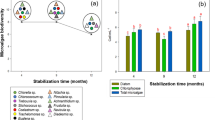Abstract
Molasses wastewater (vinasse; the by-product of distillation of fermented sugar) was decolorized and its chemical oxygen demand (COD) was reduced in static cultivation using the fungiCoriolus versicolor, Funalia trogii, Phanerochaete chrysosporium andPleurotus pulmonarius (‘Pleurotus sajorcaju’). The effect of cotton stalk on decolorizing and COD removing capability of four fungi was determined. In the entire concentration range tested (10–30 %), wastewater was effectively decolorized byC. versicolor andF. trogii. Cotton stalk addition stimulated the decoloization activity of all fungi. The utilization of cotton stalk represents several advantages due to its function as an attachment place and as a source of nutrients; its use also reduces process costs.
Similar content being viewed by others
References
Baldrian P., Gabriel J.: Variability of laccase activity in the white-rot basidiomycetePleurotus ostreatus.Folia Microbiol. 47, 385–390 (2002).
Cabrera F., Toca G.C., Diaz E., Arambarri D.E.P.: Acid mine-water and agricultural pollution in a river skirting the Donana national park (Guardi Amar river, Southwest Spain).Water Res. 18, 1469–1482 (1984).
Eichlerova I., Homolka L., Nerud F.: Decolorization of synthetic dyes byPleurotus ostreatus isolates differing in ligninolytic properties.Folia Microbiol. 47, 691–695 (2002).
Fahy V., FitzGibbon F.J., McMullan G., Singh D., Marchant R.: Decolorization of molasses spent wash byPhanerochaete chrysosporium.Biotechnol.Lett. 19, 97–99 (1997).
FitzGibbon F.J., Nigam P., Singh D., Marchant R.: Biological treatment of distillery waste for pollution-remediation.J.Basic Microbiol. 35, 293–301 (1995).
Garcia Garcia I., Bonilla Venceslada J.L., Jimenez Pena P.R., Ramos Gomez E.: Biodegradation of phenol compounds in vinasse usingAspergillus terreus andGeotrichum candidum.Water Res. 31, 2005–2011 (1997).
Gonzales Benito G., Pena Miranda M., Rodriguez de Los Santos D.: Decolorization of wastewater from an alcoholic fermentation process withTrametes versicolor.Biores.Technol. 61, 33–37 (1997).
Gonzales Benito G., Pena Miranda M., Garcia Cubero M.T., Uruena Alonso A.M.: Decolorization of molasses effluents by coagulation-flocculation process.Zuckerindustrie 5, 406–410 (1999).
Kahraman S., Yeşilada O.: Effect of spent cotton stalks on color removal and chemical oxygen demand lowering in olive oil mill wastewater by white rot fungi.Folia Microbiol. 44, 673–676 (1999).
Kahraman S., Yeşilada O.: Industrial and agricultural wastes as substrates for laccase production by white-rot fungi.Folia Microbiol. 46, 133–136 (2001).
Koutinas A.A., Toutouzidakis G., Kana K., Kounis I.: Methane fermentation promoted by alumina pellets.J.Ferment.Bioeng. 72, 64–67 (1991).
Kumar V., Wati L., Nigam P., Banat I.M., McMullan G., Singh D., Marchant R.: Microbial decolorization and bioremediation of anaerobically digested molasses spent wash effluent by aerobic bacterial cultures.Microbios 89, 81–90 (1997a).
Kumar V., Wati L., FitzGibbon F., Nigam P., Banat I.M., Singh D., Marchant R.: Bioremediation and decolorization of anaerobically digested distillery spent wash.Biotechnol.Lett. 19, 311–313 (1997b).
Miller G.L.: Use of dinitrosalicylic acid reagent for determination of reducing sugar.Anal.Chem. 31, 426–428 (1959).
Miyata N., Iwahori K., Fujita M.: Manganase-independent and dependent decolorization of melanoidin by extracellular hydrogen peroxide and peroxidases fromCoriolus hirsutus pellets.J.Ferment Bioeng. 85, 550–553 (1998).
Nakajima-Kambe T., Shimomura M., Nomura N., Chanpornpong T., Nakahara T.: Decolorization of molasses wastewater byBacillus sp. under thermophilic and anaerobic conditions.J.Biosci.Bioeng. 87, 119–121 (1999).
Novotny Č., Vyas B.R.M., Erbanova P., Kubátová A., Šašek V.: Removal of PCBs by various white rot fungi in liquid cultures.Folia Microbiol. 42, 136–140 (1997).
Ohmomo S., Itoh N., Watanabe Y., Kaneko Y., Tozawa Y., Ueda K.: Continuous decolorization of molasses waste water with mycelia ofCoriolus versicolor Ps4a.Agr.Biol.Chem. 49, 2551–2555 (1985).
Ohmomo S., Kainuma M., Kamimura K., Sirianuntapiboon S., Aoshima I., Atthasampunna P.: Adsorption of melanoidin to the mycelia ofAspergillus oryzae Y-2-32.Agr.Biol.Chem. 52, 381–386 (1988).
Pena Miranda M., Gonzales Benito G., San Cristobal N., Heras Nieto C.: Color elimination from molasses wastewater byAspergillus niger.Biores.Technol. 57, 229–235 (1996).
Rodríguez Couto S., Dominguez A., Sanromán Á.: Production of manganese-dependent peroxidase in a new solid-state bioreactor byPhanerochaete chrysosporium grown on wood shavings. Application to the decolorization of synthetic dyes.Folia Microbiol. 47, 417–422 (2002).
Rosenberg S.L.: Transformation of lignocellulose.Symp.Biol. 12, 133–142 (1980).
Sam M., Yeşilada O.: Decolorization of orange II dye by white rot fungi.Folia Microbiol. 46, 143–145 (2001).
Standard Methods for the Examination of Water and Wastewater, 14th ed. American Public Health Association, Washington (DC) 1979.
Verma P., Madamwar D.: Decolorization of synthetic textile dyes by lignin peroxidase ofPhanerochaete chrysosporium.Folia Microbiol. 47, 283–286 (2002).
Vyas B.R.M., Volc J., Šašek V.: Ligninolytic enzymes of selected white rot fungi cultivated on wheat-straw.Folia Microbiol. 39, 235–240 (1994).
Yeşilada O., Fiskin K.: The use of white rot fungi for evaluation and degradation of vinasse.Turk.J.Biol. 19, 181–189 (1995).
Yeşilada O., Fiskin K., Yeşilada E.: The use of white rot fungusFunalia trogii (Malatya) for the decolorization and phenol removal from olive oil mill wastewater.Environ. Technol. 16, 95–100 (1995).
Yeşilada O., Sik S., Sam M.: Biodegradation of olive oil mill wastewater byCoriolus versicolor andFunalia trogii: effects of agitation, initial COD concentration, inoculum size and immobilization.World J.Microbiol. Biotechnol. 14, 37–42 (1998).
Zilly A., Souza C.G.M., Barbosa-Tessmann I.P., Peralta R.M.: Decolorization of industrial dyes by a Brazilian strain ofPleurotus pulmonarius producing laccase as the sole phenol-oxidizing enzyme.Folia Microbiol. 47, 273–278 (2002).
Author information
Authors and Affiliations
Corresponding author
Additional information
This research was supported byTurkish Republic Prime Ministry State Planning Organization (project no. 97K121470).
Rights and permissions
About this article
Cite this article
Kahraman, S., Yeşilada, O. Decolorization and bioremediation of molasses wastewater by white-rot fungi in a semi-solid-state condition. Folia Microbiol 48, 525–528 (2003). https://doi.org/10.1007/BF02931335
Received:
Issue Date:
DOI: https://doi.org/10.1007/BF02931335




